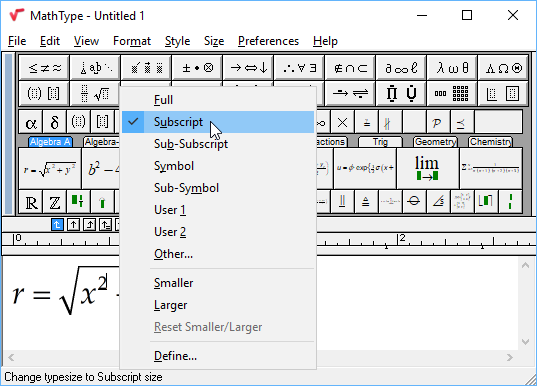

- #Powerpoint equation editor bars over variables too small how to
- #Powerpoint equation editor bars over variables too small full
To Change Display Size of an Equation in MS Word.

An inserted template will wrap itself around anything that is selected. a parenthesis template), then insert the wrapping template in the normal way. Just select the part of the equation to be wrapped (ex.Hold the Alt key down while choosing the replacement template in the palette menus.To return to Math style, choose Math from Style menu.Place insertion point and go to Style, select Text, type using space bar.Using Text Style Mode will allow you to use the space bar to add space between words.To change back into math model press Ctrl+Plus (or go to Style and select Math).Press Ctrl+Shift+E (or go to Style and select Text) to place equation editor into text mode.When you type a word like “variation” or “single”, it will show up in the equation editor as “variation” or “sin gle” because “var” or “sin” is a recognized function name.If the characters under the arc are 12 points, you may need to make the arc around 40 points in size. You may not be able to cover them completely before the arc starts to look ugly but do the best you can. Use the Other command on the Size menu to increase the size of the arc until it covers the characters.Use the Other command on the Style menu to select the MT Extra font.Click into the smaller slot to place the insertion point there.Type the material to go under the arc into the lower slot.Insert the "small-over-large" template (it's on the 3rd template palette from the left).Tip 4:Placing an Arc over More thanOne Character If you want them dotted, click three times. If you want the lines to be dashed, click twice. This will insert solid lines around the matrix. In the matrix dialog box, click in the preview pane outside the matrix on all four sides. Click on this button and drag it to the toolbar, placing it wherever you want it. On the left, click on "Insert." On the right, scroll down and near the bottom of the list will be this button. You will see a list of Categories on the left and a list of Commands on the right.Click on the Commands tab to display the list of commands.To add the icon, choose the Customize command on the Tools menu to display the Customize dialog.Tip 2:Creating a Toolbar button in MS Word that Inserts and Equation In Equation Editor go to the Help menu and select Equation Editor Help.There are 19 palettes in equation editor.

#Powerpoint equation editor bars over variables too small full
#Powerpoint equation editor bars over variables too small how to
You’ll learn how to use the parameters of the method main in Chapter 9 in the section Command Line Arguments. The method main has parameters - and an array of text values String args. It’s the data that could be given to the method from another place of the program that invokes this method. arguments), which go inside the parentheses. The method name main goes right before parentheses. The keyword void means that the method main doesn’t return any data to whomever calls it (JRE in this case). We’ll talk about classes and object instances in the next chapter.ĭoes the method main return any data? Say, if you’ll write a method to add two numbers, it can return a result. The keyword static means that you don’t have to create an instance of the HelloWorld object in memory to use this method. The keyword public means that the method main could be accessed by any other Java class or the JRE itself. Preparing to Process the Keys S, Q, and N Processing Keyboard Events in the Controller Networking: Downloading Files From the Internet Serialization: Turning an Object Into Bytes Project: Adding Events Handling for Calculator Data Exchange Between GUI Components And Controller Designing a Sign In Window in Scene Builder Access Levels, Collections, Generics, and Multi-Threading Project: Java Interfaces and Lambda Expressions What’s the difference between abstract classes and interfaces? Interfaces, Lambdas, Abstract and Anonymous Classes Meet Classes - the Main Language Constructs


 0 kommentar(er)
0 kommentar(er)
